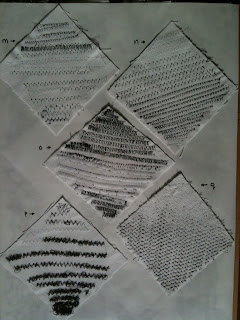Machined Stitched Strips
(Puffer Fish)
3.6 Four samples of stitched strips
(Eurasian Jay)
Next, I tried the Eurasian Jay with as close to a whip stitch as my machine would go. Varied the top tension button on each row (6-7 for dark, 0-1 for light) to get the varieties of shading. Pleased with the results (but 5 hours for 2 strips?!?!?!) - 3.6 [2] above.
(Sparrow Feathers)
Then worked on Sparrow Feathers. Used the cable stitch for the feathers' central shafts, then turn the strip over and filled in next to each shaft with whip stitches in wide zigzag and then triple stitch zigzag. Interesting effect - 3.6 [3] above.
(Wet Cheetah Fur)
Finally attempted "Wet Cheetah Fur" as the basis for the next strip - 3.6 [4] above. Used a zigzag back and forth to fill in a small patch, leaving the threads on the front hanging. Found that it was best not to have too orderly a pattern - random worked better. Like this effect very much, but again, 5 hours for 2 strips???!
3.7 Machined strips based on animal patterns
Finally, to see what it would look like on a black background, I make three more strips, using white thread, stitching in layers of different directions.
The first strip, 3.7 [1] above uses the spider web as inspiration. In 3.7 [2] above I was using an image of elephant skin as the pattern. 3.7 [3] above is based on the pattern of a giraffe.
(giraffe, elephant, spider web)
OBSERVATIONS on this Chapter....
Although this chapter took many months to complete due to interruptions in "life", I was happy to learn 1) it is possible to manipulate a sewing machine to achieve a variety of effects, 2) on a machine, thread can be used like charcoal - using it in different ways (thicknesses, densities, stitch types) to produce shades, 3) understanding how these different techniques work allows you to interpret textures in a wider variety of ways.
Some of the methods were tedious and time-consuming, yet often yielded the best results, I felt. Also, even a very simple sewing machine can produce quite a variety of effects. I'm sure there are more that I did not even consider.
However, at some point, I would like to learn how to manipulate the length of stitches and to see what effects can be produced with a greater variety of stitch styles.
- * - * - * - * - * - * - * - * -
Total hours Chapter 3: 15











